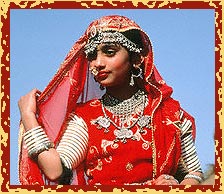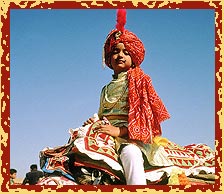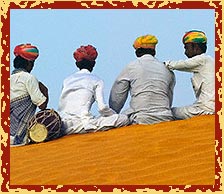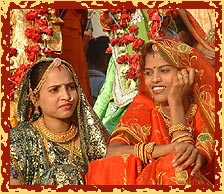Rajasthan Travels ::
Rajasthan Art & Culture ::
Rajasthan Traditional Dresses
Rajasthan Traditional Dresses
A Symphony Of Colours

Against the backdrop of dusty land and sun-soaked skies, Rajasthan is filled with opulent colours, the sparkle of mirror and silver and precious stones, and the sheen of silk and vivid kaleidoscope of cotton. The exotic and vividly colorful state of Rajasthan is synonymous with majestic forts, stately palaces, lakes, sand dunes, camels and people dressed in brightly coloured costumes.
To add a dash of colour and life to the barren, colorless landscape and the monotonous, cloudless sky, the people of Rajasthan show a distinct preference for bright costumes. From the simple village folk or tribal belle to the royalty, the preferred colours are bright red, dazzling yellow, lively green or brilliant orange, highlighted by a lavish use of sparkling gold and silver 'zari' or 'gota'.
The dyers of Rajasthan and neighbouring Gujarat were masters of their craft from the dawn of history. Their unsurpassed skill is still evident in the costumes worn by the Rajasthani people, both rich and poor.
The study of the people of Rajasthan is incomplete without the knowledge of costumes and ornaments. The costumes of the present have the reflections of the costumes of the past. Clothes express one's personality and distinguish people of different places from each other.
The Brilliance Of Hues
Both males and females dress in the customary dresses fully influenced by climate, economy, status and the profession. The traditional dresses being 'potia', 'dhoti', 'banda', 'angrakha', 'bugatari', 'pachewara', 'khol', 'dhabla', amongst Hindus; and 'tilak', 'burga', 'achkan' amongst Muslims, which are fast changing now with 'bushirt', 'salwar' and 'skirts', saris and pants accordingly.
Turban, the head dress of Rajasthani men, is a differential pattern, of each geographical region designed to suit terrain and climatic influence. All over Rajasthan, the 'bandhni', the tie-and-dye sari and turban reign supreme.
The common dress of the women constitutes (i) sari or 'odhani', (ii) 'kanchli' or 'kunchuki' or 'choli' (iii) 'ghaghra' or 'ghaghri' or 'lahanga'. Besides, the women of high status and ranks wear 'dupatta' and 'patka'.
The use of chappals or sandals or 'jutees' is also common but ladies of high families use coloured sandals studded with gold threads and stars.
The Diverse Attire
 Royal Wardrobe
Royal Wardrobe
The rich and opulent dresses of the royalty were made under the meticulous attention of special departments in charge of royal costumes while the 'Ranghkhana' and the 'Chhapakhana' were departments that took care of dyeing and printing the fabrics respectively. The 'siwankhana' ensured its flawless and articulate tailoring. Two special sections, the 'toshakhanand' and the 'kapaddwadra', took care of the daily wear and formal costumes of the king.
Traditional Textiles
Rajasthani daily wear such as saris, 'odhnis' and turbans are often made from textiles using either block printed or tie-and-dye techniques.
Rajput Costumes
The Rajput kings, owing their close proximity to the Mughal court dressed up in their colorful and formal best. Richly brocaded material from Banaras and Gujarat, embroidered and woven Kashmiri shawls and delicate cottons from Chanderi and Dhaka were procured at great cost.
Women's Attire
Odhni
It is 10 feet long and 5 feet wide, One corner is tucked in the skirt while the other end is taken over the head and right shoulder. Colours and motifs are particular to caste, type of costume and occasion. Both Hindu and Muslims women wear 'odhnis'.
Pila
An 'odhni' with a yellow background and a central lotus motif in red called a 'pila', is a traditional gift of parent to their daughter on the birth of a son. The vibrant and colorful land of Rajasthan, with hospitable and well-attired men and women add a splash of colour to the otherwise parched landscape.
Men's Attire

The turban, variously called 'pagari', 'pencha', 'sela' or 'safa' depending on style, an 'angrakha' or 'achakan' as the upper garment and 'dhoti' or 'pyjama' as the lower garment make up the male outfit.
Turban Styles
Varying styles of turban denote region and caste. These variations are known by different names such as 'pagari' and 'safa'. Infact, there are about 1,000 different styles and types of turbans in Rajasthan, each denoting the class, caste and region of the wearer. Turbans come in all shapes, sizes and colours; and there are specific turbans for specific occasions as well.
A 'pagari' is usually 82 feet long and 8 inches wide. A 'safa' is shorter and broader. The common man wears turban of one color, while the elite wear designs and colors according to the occasion.
Headgear / Turbans
Varying styles of turban denote region and caste. These variations are known by different names such as 'pagari' and 'safa¿. Infact, there are about 1,000 different styles and types of turbans in Rajasthan, each denoting the class, caste and region of the wearer. Turbans come in all shapes, sizes and colours; and there are specific turbans for specific occasions as well.
A 'pagari' is usually 82 feet long and 8 inches wide. A 'safa' is shorter and broader. The common man wears turban of one color, while the elite wear designs and colors according to the occasion
Way Of Dressing
Traditional textiles
Rajasthani daily wear such as saris, 'odhnis' and turbans are often made from textiles using either block printed or tie-and-dye techniques.
Rajput Costumes
The Rajput kings, owing their close proximity to the Mughal court dressed up in their colorful and formal best. Richly brocaded material from Banaras and Gujarat, embroidered and woven Kashmiri shawls and delicate cottons from Chanderi and Dhaka were procured at great cost.
 Colours, Hues & Themes
Colours, Hues & Themes
Against the backdrop of dusty land and sun-soaked skies, Rajasthan is filled with opulent colours, the sparkle of mirror and silver and precious stones, and the sheen of silk and vivid kaleidoscope of cotton. The exotic and vividly colorful state of Rajasthan is synonymous with majestic forts, stately palaces, lakes, sand dunes, camels and people dressed in brightly coloured costumes.
To add a dash of colour and life to the barren, colorless landscape and the monotonous, cloudless sky, the people of Rajasthan show a distinct preference for bright costumes.
From the simple village folk or tribal belle to the royalty, the preferred colours are bright red, dazzling yellow, lively green or brilliant orange, highlighted by a lavish use of sparkling gold and silver 'zari' or 'gota'.
The dyers of Rajasthan and neighbouring Gujarat were masters of their craft from the dawn of history. Their unsurpassed skill is still evident in the costumes worn by the Rajasthani people, both rich and poor.
The study of the people of Rajasthan is incomplete without the knowledge of costumes and ornaments. The costumes of the present have the reflections of the costumes of the past. Clothes express one's personality and distinguish people of different places from each other.


 Against the backdrop of dusty land and sun-soaked skies, Rajasthan is filled with opulent colours, the sparkle of mirror and silver and precious stones, and the sheen of silk and vivid kaleidoscope of cotton. The exotic and vividly colorful state of Rajasthan is synonymous with majestic forts, stately palaces, lakes, sand dunes, camels and people dressed in brightly coloured costumes.
Against the backdrop of dusty land and sun-soaked skies, Rajasthan is filled with opulent colours, the sparkle of mirror and silver and precious stones, and the sheen of silk and vivid kaleidoscope of cotton. The exotic and vividly colorful state of Rajasthan is synonymous with majestic forts, stately palaces, lakes, sand dunes, camels and people dressed in brightly coloured costumes.  Royal Wardrobe
Royal Wardrobe  The turban, variously called 'pagari', 'pencha', 'sela' or 'safa' depending on style, an 'angrakha' or 'achakan' as the upper garment and 'dhoti' or 'pyjama' as the lower garment make up the male outfit.
The turban, variously called 'pagari', 'pencha', 'sela' or 'safa' depending on style, an 'angrakha' or 'achakan' as the upper garment and 'dhoti' or 'pyjama' as the lower garment make up the male outfit.  Colours, Hues & Themes
Colours, Hues & Themes